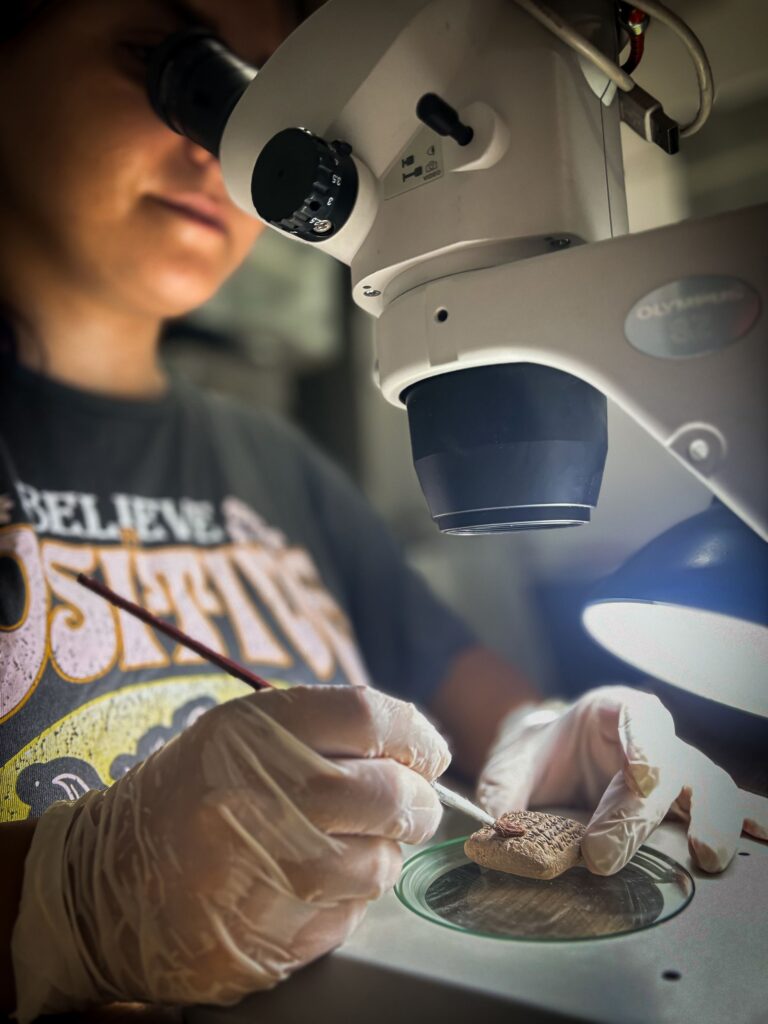September 30, 2024
Archaeologists at Tell Atchana have discovered a 3,500-year-old clay tablet, a remarkable find following the Turkey-Syria Earthquake.
In 2023, the AIA established the Nancy Wilkie Emergency Funds for Heritage Preservation to provide immediate aid to threatening conditions at some of the world’s most treasured archaeological sites. We received over $100,000 in donations from generous donors to help fund this program.
The 2023-2024 Wilkie Emergency Funds were utilized to support the preservation of two sites impacted by the same geological disaster, the February 2023 Turkey-Syria Earthquake.
Dr. Murat Akar and his team, who received the 2023 Wilkie Emergency Funds, were featured on CNN for their recent discovery of a Late Bronze Age cuneiform tablet. Dr. Akar’s team took swift action after the Turkey-Syria Earthquake, which posed a severe threat to the ancient site of Tell Atchana, the capital of the regional kingdom of Mukish. The AIA-Wilkie Funds have played a critical role in this urgent project by providing essential support for the restoration work, including preserving the surviving mud brick walls that partially collapsed during the earthquake. Click here to read the full CNN article.
The AIA reached out to Dr. Akar to learn how the Wilkie Funds have impacted the project:
Why were the emergency funds needed in a quick/timely manner?
Tell Atchana, Alalakh is an important Bronze Age site that was initially excavated by British Archaeologist Sir Leonard Woolley. His large-scale exposures at the site revealed Middle and Late Bronze Palaces, Gateways and Temple Complexes. Both palaces were severely burnt thus allowing the mud brick architecture to survive up to 4 meters of height in some parts. However, due to the nature of the mud brick architecture, most of the walls were decayed over the course of the last 80 years. The conditions got worse with the February 6th Kahramanmaraş earthquakes. As the Tell Atchana excavation team, we were already working to preserve the site before the earthquake, but now it has become a major necessity as many of the walls of the palaces collapsed during the earthquake.
How were the funds used to preserve the site?
We have initiated a massive preservation project which requires multiple steps to be achieved. We are cleaning the collapsed, decayed walls for preparation of the restoration work. At the same time, we are also re-excavating 1930’s excavation dump, sifting it and converting it to new mud bricks produced at the site by using straw and water mixture. Third step is capping which means, we are sealing the original mud brick walls first with geo-textile and building walls around them with newly produced mud bricks according to the Bronze Age standards. The details of the restoration work which began last year is already published in the Journal of Field Archaeology.
What impact did the funds have on the site/project?
The major impact is the possibility of conducting a long-term field season. We have been on site from May onwards thanks to multiple funding sources. Every process requires an enormous amount of heavy work, so every bit of funding source is absolutely important for us. The other important aspect is the recognition of the site. Tell Atchana deserves to be a World Heritage site which was unfortunately left to decay for almost a century. So discoveries such as the new tablet during the restoration work adds further to the visibility of the site.
I will be at the Getty Institute at the end of this month for around 3 months to further pursue matters on earthen architecture preservation. So I will be happy to present the results as an AIA lecture if requested.
We do have a social media account that details the process of restoration at the site. I will be happy also to provide further visuals. Please check @tellatchana on instagram!
📸 Murat Akar/Mustafa Kemal University


